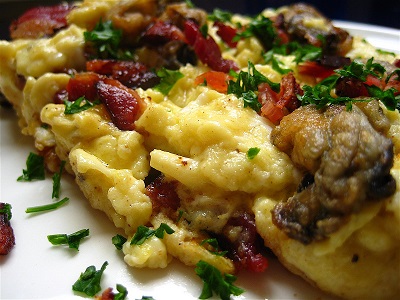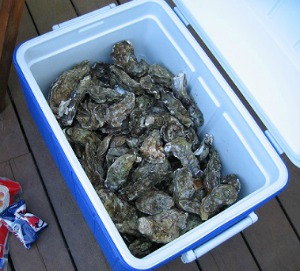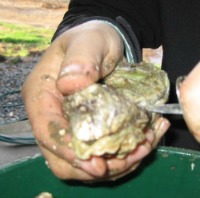
Hangtown Fry History:
1849 – During the late 1800s, Hangtown (known as Placerville today) was a base of supply for the mining region in California. It was originally known as Old Dry Diggins (it was called Dry Diggins because the miners had to cart the dry soil down to the running water to wash out the gold), but was shortly labeled Hangtown after three desperadoes had been hanged there on the same day and from the same giant white oak tree. The only stump that remains of the original tree is hidden in the cellar of a bar on Main Street in Placerville named -quite aptly – “The Hangmans Tree.”
Legend has it that the Hangtown Fry originated in the saloon of the El Dorado Hotel, now the site of the Cary House Hotel, across the street from the Hangman’s Tree. The El Dorado Hotel burned down in one of the great fires of 1856 that leveled most of Hangtown, which by that time had become a growing Gold Rush city named Placerville. On the side of the El Dorado Hotel, the large brick Cary House Hotel was built where it still stands to this day on Placerville’s Main Street. It is interesting to note that some say the owner of the Gary House recovered enough gold from under the building to pay for the cost of restoration.
Mountain Democrat newspaper columnist, Doug Noble, wrote this interesting and charming story of how the event could have taken place:
In 1849, just a short time after Old Dry Diggins had been renamed Hangtown in honor of the recent hanging of three desperadoes from the large oak tree on Main Street, a prospector rushed into the saloon of the El Dorado Hotel announcing that right there in town, along the banks of Hangtown Creek, he had struck it rich and had every reason to celebrate. Untying his leather poke from his belt, he tossed it on the bar where it landed heavily, spilling its shining contents of gold dust and nuggets. Turning to the bartender he loudly demanded, “I want you to cook me up the finest and most expensive meal in the house. I’m a rich man and I’m going to celebrate my good luck.”
The Bartender called to the cook and relayed the prospector’s order. The cook stopped what he was doing and came out of the kitchen. Looking the prospector in the eye he said, “The most expensive things on the menu are eggs, bacon and oysters. The eggs have to be carefully packed to travel the rough road from over the coast; the bacon comes by ship round the horn from back east; and the fresh oysters we have to bring up each day on ice from the cold waters of San Francisco Bay. Take your choice. I can cook you anything you want, but it will cost you more than just a pinch of that gold dust you have there.”
The prospector said, “Scramble me up a whole mess of eggs and oysters, throw in some bacon, and serve ’em up. I’m starving. I’ve been living on nothing much more than canned beans since I got to California, and at last I can afford a real meal.” The cook did just that, cooking up a full plate of the mixture. Thus the Hangtown Fry was invented.
The Hangtown Fry is the official dish of both the city of Placerville and the county of El Dorado. There is also a group known as the Hangtown FRYers trying to promote the dish as the “Official Dish of the Great State of California,” according to Doug Noble. Doug said, “The state legislature is cool on the subject, as they have no sense of humor. We actually got some support from a restaurant in Sydney, Australia. They love Hangtown Fry.”
1853 – According to George Leonard Herter and Berthe E. Herter, from their book Bull Cook and Authentic Historical Recipes and Practices, they wrote:
In the eighteen hundreds San Francisco was quite a town. The Barbary Coast which was a section of saloons and houses of prostitution, was know the world over as second only to similary areas in Rio and Hong Kong . . . In 1853, a man named Parker opened a saloon called Parker’s Bank Exchange in the Montgomery Block. a famous building built by General Halleck. Parker invented and served a dish called Hangtown Fry. Its fame spread all over San Francisco and the surrounding areas. A few drinks and a Hangtown Fry was and is considered a gentleman’s evening . . . Today the real Hangtwon Fry is no longer to be found in San Francisco or anywhere else. It still is on the menus but when you get it you get nothing buy an egg omelet with oysters and a couple of pieces of bacon across the top. The real Hangtown Fry is too slow to make and too expensive for our modern day restaurants.
Hangtown Fry Recipes:
This recipe has been adapted from the Blue Bell Cafe (no longer in business) which was on Placerville’s Main Street made this version of the Hangtown Fry for many years.
- 1 egg, beaten
- 1 tablespoon milk, or cream
- 3 oysters, live, raw, and shucked fresh
- Breading Mixture, mixture of cracker and bread crumbs)
- Vegetable Oil, or butter, (I like to use butter)
- 2 slices bacon, thick-sliced
- 2 egg, whole
-
 Learn how to How To Shuck Oysters.
Learn how to How To Shuck Oysters. -
Pat the shucked oysters dry with paper towels to remove moisture.
In a small bowl, beat egg with the milk or cream. Dip the oysters in the egg/milk mixture and then the Breading Mixture.
In a frying pan, heat the vegetable oil or butter. Add the oysters and fry approximately 30 seconds on each side or until three-fourths (3/4) cooked. Remove from heat and set aside.
While frying the oysters, fry the bacon in another skillet until just before the bacon becomes crisp.
In a small bowl, beat the eggs lightly; set aside.
Place the bacon (like railroad tracks off-center) in a large frying pan over low heat. Pour a small amount of the beaten egg over the top of the bacon. Place the partially cooked oysters on top of the bacon and then pour the remaining beaten eggs over the top.
Cook approximately 2 minutes or until the eggs are set (eggs are done when creamy, soft and a bit runny; do not overcook).
Then fold the omelets over the oysters. Place a lid over it and cook just until the steam blends together all the flavors.
Makes 1 serving.
Hangtown Fry Recipe II:
This recipe is from the February 1975 Gourmet Magazine.
Shuck the oyster and pat them dry with paper towels.
In a small bowl, beat eggs and cream together.
In a 7-inch skillet, saute the oysters in bacon fat over moderate heat for 1 minute. Add eggs/cream mixture, salt, and pepper to taste.
Cook the mixture over moderate heat for 2 minutes or until the eggs are set.
Remove from heat and invert the mixture onto a heated plate and serve it with crisply fried bacon.
Makes 1 serving.
-
How To Store Fresh Oysters:
 Keep the unopened oysters cold but do not store in water! Remember, oysters are alive and need to breathe, so never seal them tightly in a plastic bag.
Keep the unopened oysters cold but do not store in water! Remember, oysters are alive and need to breathe, so never seal them tightly in a plastic bag.
Sandwich a layer of live oysters between two (2) beds of ice. Place them deep side down (to retain their juices). I do this in a portable (picnic-type) chest cooler. Never immerse live oysters in fresh water or melted ice – it will kill them. Oysters stored this way will keep for 2 days. This is the method to use if you plan on using the fresh oysters soon.
Store live oysters in the refrigerator at 40 degrees F. if they are not to be used immediately. Place them deep side down (to retain their juices) in an open container. Cover the oysters with a damp towel or layers of damp newspaper. Oyster store this way will keep up to 5 to 7 days.
Open (shuck) shortly before serving – not more than 2 hours. The colder the oyster, the easier it is to shuck. Keep oysters cold at all times, partly for safety and very much to enhance flavor and texture.
Sources:
Bull Cook and Authentic Historical Recipes and Practices, by George Leonard Herter and Berthe E. Herter, published by Herter’s Inc., 1960.
City of Placerville, City History.
The Origin of the Hangtown Fry, by Doug Noble, Mountain Democrat newspaper, July 31, 2000.
Gourmet Magazine, February 1975.
Categories:
Egg Recipes Far West Fish and Seafood History Food History Oyster Main Course Scrambled Egg Dishes
 Learn how to
Learn how to
3 Responses to “Hangtown Fry History and Recipe”
Daniel Bentley
“Could be the first California cuisine?” I would say the food of the displaced tribal people would have that honor.
lois
MY stepmom used to make a mock hangtown fry by using Chicken livers in stead of oysters. It was goo!. A friend is going to be opening a restaurant and wanted oginal recipes from that era. Can you help?
Valerie Woodring
I saw a history show on T.V. and decided to try the recipe, it’s wonderful and the history behind it is amazing,